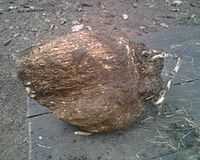Wolfiporia extensa
From Wikipedia, the free encyclopedia
| Wolfiporia extensa | |
|---|---|
 | |
| Wolfiporia extensa sclerotium | |
| Scientific classification | |
| Kingdom: | Fungi |
| Division: | Basidiomycota |
| Class: | Agaricomycetes |
| Order: | Polyporales |
| Family: | Fomitopsidaceae |
| Genus: | Wolfiporia |
| Species: | W. extensa |
| Binomial name | |
| Wolfiporia extensa | |
| Synonyms | |
Wolfiporia extensa (Peck) Ginns (formerly known as Poria cocos F.A. Wolf) is a fungus in the Polyporaceae family. It is a wood-decay fungus but has a terrestrial growth habit. It is notable in the development of a large, long-lasting underground sclerotium that resembles a small coconut. This sclerotium (called "Tuckahoe", or Indian bread) was used by Native Americans as a source of food in times of scarcity. It is also used as a medicinal mushroom in Chinese medicine.[1]
Common names include hoelen, poria, tuckahoe, China root, fu ling (茯苓, pīnyīn: fúlíng), and matsuhodo.
References
- ↑ Esteban CI (2009). "Interés medicinal de Poria cocos (= Wolfiporia extensa)" [[Medicinal interest of Poria cocos (= Wolfiporia extensa)]] (PDF). Rev Iberoam Micol (in Spanish) 26 (2): 103–7. doi:10.1016/S1130-1406(09)70019-1. PMID 19631158.
External links
- Wolfiporia extensa in Index Fungorum.
- Hoelen (Poria)
- Medicinal Mushrooms: Their Therapeutic Properties and Current Medical Usage with Special Emphasis on Cancer Treatments by Cancer Research UK, 2001
This article is issued from Wikipedia. The text is available under the Creative Commons Attribution/Share Alike; additional terms may apply for the media files.